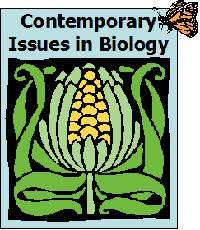
Week 8, Chapter 14 -- Adopt-a-Species Sample Assignment
Course home | Weekly schedule | Announcements | Instructor Info | Desire2Learn | MasteringBiology® | Honor Code | FAQs | HELP!
 |
Week 8, Chapter 14 -- Adopt-a-Species Sample AssignmentCourse home | Weekly schedule | Announcements | Instructor Info | Desire2Learn | MasteringBiology® | Honor Code | FAQs | HELP! |
To: The Save the Kanab Ambersnail Foundation Grant Program
To Whom it May Concern:
I am proposing to study how the extinction of the Kanab ambersnail would affect the plant community at Vasey’s Paradise in Grand Canyon National Park. Vasey’s Paradise is renowned for its beautiful vegetation and is an important tourist destination. The loss of the Kanab ambersnail could have a negative impact on the Vasey’s Paradise plant community, making it less popular with tourists, which could ultimately lead to a loss of revenue for the community.
The Kanab ambersnail lives near a handful of springs in Utah and Arizona. The snails that live in Arizona are found in just two sites within Grand Canyon National Park, Upper Elves Chasm and Vasey’s Paradise. The Vasey’s Paradise ecosystem is an “oasis” growing on the limestone walls of the Grand Canyon. Vasey’s Paradise is sustained by a spring-fed waterfall that emerges high on the canyon wall before cascading to the Colorado River below. The waterfall supports a diverse community of plants and invertebrates, including the Kanab ambersnail.
Vasey’s paradise is a popular destination for tourists. Tourism is one of the most important sources of revenue to the community that lives near Grand Canyon National Park. Therefore, Vasey’s paradise provides an important ecosystem service by attracting tourists to the region.
Although few studies of the Kanab ambersnail’s diet have been conducted, it likely has a diet similar to that of other snails. Snails typically consume algae and bacteria growing on plants. When organisms that eat algae, like snails, are not present, algae can grow to high densities. High densities of algae can degrade the aesthetic value of ecosystems and even lead to the death of more attractive plants by shading them and preventing them from acquiring sunlight needed for photosynthesis. Therefore, the presence of Kanab ambersnails at Vasey’s paradise may be essential to maintaining high aesthetic quality and a healthy plant community.
The specific objective of this experiment is to examine the effect of Kanab ambersnail removal on algae density and aquatic plant health in Vasey’s paradise. Specifically, I hypothesize that removal of Kanab ambersnails will affect algae density, plant density and plant health. To test this hypothesis, I will remove snails from enclosures in Vasey’s paradise and compare algae density, plant density and plant health in enclosures with and without snails.
This experiment will be conduced in six one-square-meter experimental enclosures placed within the Vasey’s paradise ecosystem. The experimental enclosures will not have a top, so water and sunlight conditions will be the same inside and outside of the enclosures. However the walls of the enclosures will be constructed of a material that snails can not climb. This will ensure that snail migration into or out of the enclosures will not change the snail densities inside of the enclosures. I will remove all Kanab ambersnails from all six enclosures. The average density of Kanab ambersnails in Vasey’s paradise is 50 per square meter, so I will collect 150 snails and add 50 snails to three of the enclosures. Snails will be randomly assigned to an enclosure. Thus, three control enclosures will contain an average density of Kanab ambersnails, and three enclosures will contain no Kanab ambersnails. After three months, I will measure algae density, plant density, and plant health – the dependent variables in this experiment. I will measure algae density by measuring the area within the enclosures covered by algae. I will measure plant density by counting the number of plants within the enclosure, and I will measure plant health by carefully examining each plant for any signs of stress or illness.
The most important standardized variables in this experiment are factors that could affect algae density, plant density, or plant health. These include sunlight, water quality, and the presence of other algae or plant-eating organisms. Therefore, when setting up my enclosures, I will make sure that the presence of the enclosures does not interfere with any of these variables.
In the enclosures with snails, I predict that the density of algae and the density and health of plants will not change. However in the enclosures without snails, I predict that the density of algae will increase, the density of plants will decrease, and the health of plants will be degraded.
If my hypotheses are supported, this study could provide a powerful economic argument for preserving the Kanab ambersnail.
Thank you for considering my proposal.
Sincerely,
Dr. I. M. A. Gastropod, Ph.D.
[760 words]
Ecosystem Services Project. No date. What are ecosystem services? http://www.ecosystemservicesproject.org/html/overview/index.htm. Downloaded 16 August 2006.
Grand Canyon Trust. 2006. The Grand Canyon Trust is committed to protecting and restoring the Colorado Plateau. http://grandcanyontrust.org/index.php. Downloaded 15 August 2006.
Jett, Christina. 2003. Plant Management in Florida Waters: Algae. http://plants.ifas.ufl.edu/guide/2algae.html. Downloaded 16 August 2006.
Johnson, Paul D. October 2003. Sustaining America's Aquatic Biodiversity Freshwater Snail Biodiversity and Conservation. http://www.ext.vt.edu/pubs/fisheries/420-530/420-530.html#L2. Downloaded 15 August 2006.
National Park Service. Undated. Nature and Science: Kanab Ambersnail. http://www.nps.gov/grca/pphtml/highlights91.html. Downloaded 15 August 2006.
U.S. Fish and Wildlife Service. October 12, 1995. Kanab Ambersnail Recovery Plan. http://www.fws.gov/arizonaes/Kanab.htm. Downloaded 15 August 2006.
U.S. Geological Survey. 30 June, 1999. The State of Natural and Cultural Resources in the Colorado River Ecosystem. http://www.gcmrc.gov/products/score/1999/score_99_endangered.htm#KnabAmbersnail. Downloaded 15 August 2006.
Vercammen, Bill. Undated. Success at a Snail’s Pace: KAS Recovery Update. http://www.desertusa.com/mag01/nov/main/ksa.html. Downloaded 15 August 2006.
[sample assignment by Matt Chumchal]